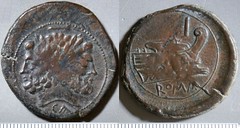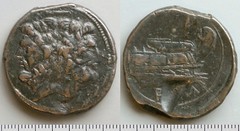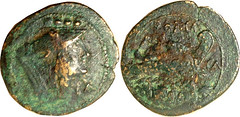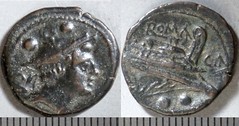Roman Coins of Luceria and Canusium, arrangement M.H. Crawford, RRC, with comments

|
Roman Coins of Luceria and Canusium, arrangement M.H. Crawford, RRC, with commentary
- General Introduction
- Luceria L - Crawford RRC 43
- Luceria L - Crawford RRC 97
- Luceria LT - Crawford RRC 98
- Luceria P - Crawford RRC 99
- Canusium CA - Crawford RRC 100
Coins of Luceria and Canusium, arrangement M.H.Crawford, RRC, Introductory comments
The purpose of this web-site is to provide illustrated examples of all the RRC varieties of the coins of Luceria (Lucera in modern Italy) and Canusium (Canosa in modern Italy), and thereby to provide a baseline for further study of the series. This presentation should help people to identify coins in this notoriously difficult series. The catalogue should be read alongside Roman Republican Coinage, Michael H. Crawford, Cambridge, 1974, to which the catalogue numbers refer.
The coin descriptions note characteristics of their designs which should serve as a basis for a future classification. For example, there are a number of coins which are described as having 'bulbous prowstems', which have a star engraved on the side of the prow, and which are of consistently heavy weight standard, are of a common engraving style, and all have thick flans. There is another group of Luceria L types, again of heavy weight, that are always struck on broad thin flans, and that have very different engraving style and design characteristics (for example, placement of mintmarks, shape of prow) when compared with the 'bulbous prowstem' group, but that have very close links to the coinage of the RRC 98 LT series. In a future reclassification of these coins, I would be minded to group coins together based on such characteristics. I have also noted many minor varieties of the coinage that were not specifically identified in RRC. In many cases these varieties can be subsumed under an existing RRC number. In other cases I have felt it necessary to introduce additional numbers, for example my new group RRC 97B, for types not included in RRC.
However the purpose of these web-pages is not (yet) to reclassify, but to present the coinage exactly as classified by Michael Crawford in RRC. This should be regarded as a baseline study.
Please refer to the main introduction for additional comments and photo credits.
- General Introduction
- Luceria L - Crawford RRC 43
- Luceria L - Crawford RRC 97
- Luceria LT - Crawford RRC 98
- Luceria P - Crawford RRC 99
- Canusium CA - Crawford RRC 100
Canusium RRC 100, arrangement M.H Crawford, RRC, with commentary
Refer: RRC p.191 (main entry); RRC p.21 (dating); RRC Appendix 146*; d'Ailly vol.ii, 631; Sydenham 309a-309h; Weight noted in RRC: 27 grams
The catalogue is formatted as a list of coin photos, with descriptions, in the order of Crawford RRC. I only comment when essential to illuminate varieties or missing types. The reader should consult Crawford RRC for additional information.
Relative to the issues of Luceria, with mintmarks L, LT or P, or without a mintmark, the issues with CA are simpler. There is no question of parallel mints or workshops, such as with the 'Roman mint' and 'Italian civic mint' issues, or the regular and possible field mint issues of RRC 99. There is also no long sequences of issues to be classified into consecutive or parallel groups, and no need to rely on the perceptions of engraving style, prowstem shape, or relative flan thickness to sort out the various types. Relatively speaking we are back to numismatics as normal. Yet RRC 100 CA is still a very complex issue by normal standards, with many overstrikes and many strange variations in mintmark location and orientation. This only helps to highlight by contrast how enormously complex were the various Luceria issues. In the case of the L and P issues, the extent of the variations call into question whether they could possibly all have been minted in one town, but for the CA issues there is a general consensus that all were minted in Canusium, today's Canosa.
CA 100/1a Canusium CA As. Horizontal bar / Janus / CA; horizontal bar / Prow / CA / ROMA. Paris d'Ailly 3070, 19g51
In contrast to RRC 99/1b, the horizontal value mark CA As is of a perfectly regular design style.
CA 100/1b Canusium CA As. Horizontal bar / Janus / CA; I / Prow / CA / ROMA. AM#0809-17, 17g18
CA 100/1b var. Canusium CA As. Horizontal bar / Janus / CA; I / Prow / ROMA. RBW 19g57. No reverse mintmark.
This coin has a mintmark on the obverse only.
CA 100/1b var. Canusium anonymous CA As. Horizontal bar / Janus; I / Prow / ROMA. AM#11209-25, 25g43. No mintmarks.
This coin has no mintmarks at all.
CA 100/1c Canusium CA As. Horizontal bar / Janus / CA; I / Prow / C over A / ROMA. Hannover 21g42. Unusual mm layout.
This Hannover coin has an odd C over A mintmark, also seen on the Semis and Triens (A over C).
CA 100/2 Canusium CA Semis. S / Saturn; S / Prow / CA / ROMA. AM#08118-14, 14g49
There is CA before the prow, slightly obscured on this coin.
CA 100/2 var. Canusium CA Semis. S / Saturn; S / Prow / C over A / ROMA. RBW 14g37. Odd mintmark layout.
Unpublished variant with C over A mintmark.
CA 100/3 Canusium CA Triens overstrike. oooo / Minerva / CA; ROMA / Prow / CA / oooo. AM#0317-56, 5g59. This is the usual common variety though mm. often not clear.
All CA Trientes can be presumed to be overstrikes, and if the mintmark location is not otherwise clear, they can be presumed to be this variety, the most common, with CA under the head and CA before the prow. This is a quite clear example and scarce as such, but these coins were more often untidily overstruck, with large remnants of the undertypes visible and with large areas of the Roman design obscured. For this reason, despite the RRC listing indicating that there is more than one mintmark variation, Crawford classifies them all under the single RRC 100/3 number. Charles Hersh assembled a wide selection of these overstrikes, which were later part of his British Museum bequest. The undertypes are of two main varieties, from cities in Western Greece: Oeniadae (Zeus right / river god Achelous right, see BM 2002,0102.5481) and Acarnanian League (Athena left / river god Achelous left, see BM 2002,0102.5480). These coins undoubtedly relate to the campaigns of Marcus Valerius Laevinus in the first Macedonian War; he captured Oeniadae in 211 BC.
CA 100/3 var. Canusium CA Triens overstrike. oooo / Minerva / CA under chin; ROMA / Prow / CA / oooo. RBW 5g90. Odd obv.mm layout.
The obverse mintmark is under the chin.
CA 100/4a Canusium CA Quadrans. ooo / Hercules; ROMA / Prow / CA / ooo. AM#9416-51, 5g10. No obv.mm.
CA 100/4b Canusium CA Quadrans. ooo / Hercules / CA under chin; ROMA / Prow / CA / ooo. Paris d'Ailly 3095, 4g36. Odd obv.mm layout.
This Quadrans has the mintmark under the chin.
CA 100/5 Canusium CA Sextans. oo, CA behind / Mercury; ROMA / Prow / CA / oo. d'Ailly 3097, 3g68. Odd obv.mm layout.
I am aware of 10 examples with the mintmark behind the head as on this coin, but only a single example, Hannover 1545, with the mintmark under the truncation.
CA 100/6a Canusium CA Uncia. o / Roma / CA. ROMA / Prow / CA / o. AM#0984-31, 3g11. CA before prow.
CA 100/6b Canusium CA Uncia. o / Roma / CA. ROMA / Prow / CAo. AM#10190-45, 4g54
CA 100/6c Canusium CA Uncia. o / Roma / CA. ROMA / Prow / oCA (unillustrated)
Even the Uncia has three reverse mintmark combinations: before the prow, CAo, and oCA.
CA 100/7 Canusium CA Semuncia. Mercury / CA; ROMA / Prow / CA. AM#0565-27, 2g65
The Semuncia is the only denomination in the series where mintmark position variants have yet to be noted.
CA 100/8 var. Luceria CA As. Fourth phase. Janus; I / Prow / ROMA. No mintmark but Janus in style of CA coinage. Irregular prow, imitative. AM#10261-24, 2g41
This is an example of a presumed imitative lightweight As related to the CA series. Note the efforts to copy the obverse style from CA Asses; the crude reverse engraving and irregular flan suggest an imitation. These coins were produced in large quantities and are often found worn indicating extensive circulation. Perhaps they were allowed to circulate as Unciae after the war. The production circumstances of all the lightweight Asses are unclear.
- General Introduction
- Luceria L - Crawford RRC 43
- Luceria L - Crawford RRC 97
- Luceria LT - Crawford RRC 98
- Luceria P - Crawford RRC 99
- Canusium CA - Crawford RRC 100
All content copyright © 2004-2012 Andrew McCabe unless otherwise noted. If you've any questions or comments please contact me on the Yahoo Group RROME: http://groups.yahoo.com/group/RROME.
Alternately you can leave comments against any coin picture, just click on the picture and write in the comment box.
See my rarity estimates for Roman Republican Bronzes: Roman Republic Bronze Rarities..















